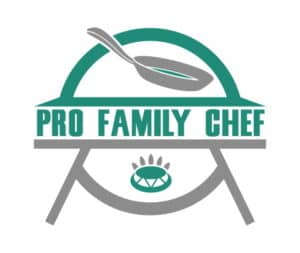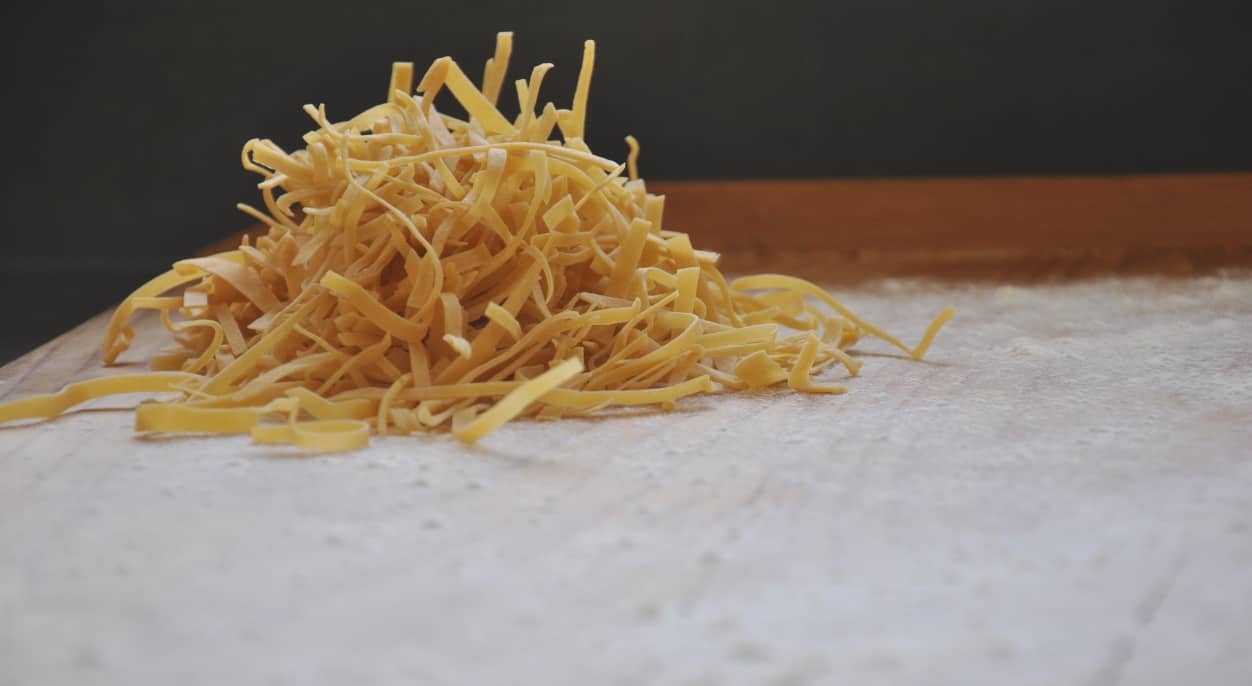So you bought a pasta board or got one for a present. Your tortellini or noodles are made, and you are left with a mess on your new wooden board.
Here is my grandmother’s kneading and pasta board. After 50 years, it is still shiny. There is a little crack here and there, but it still holds nicely together after all these years.
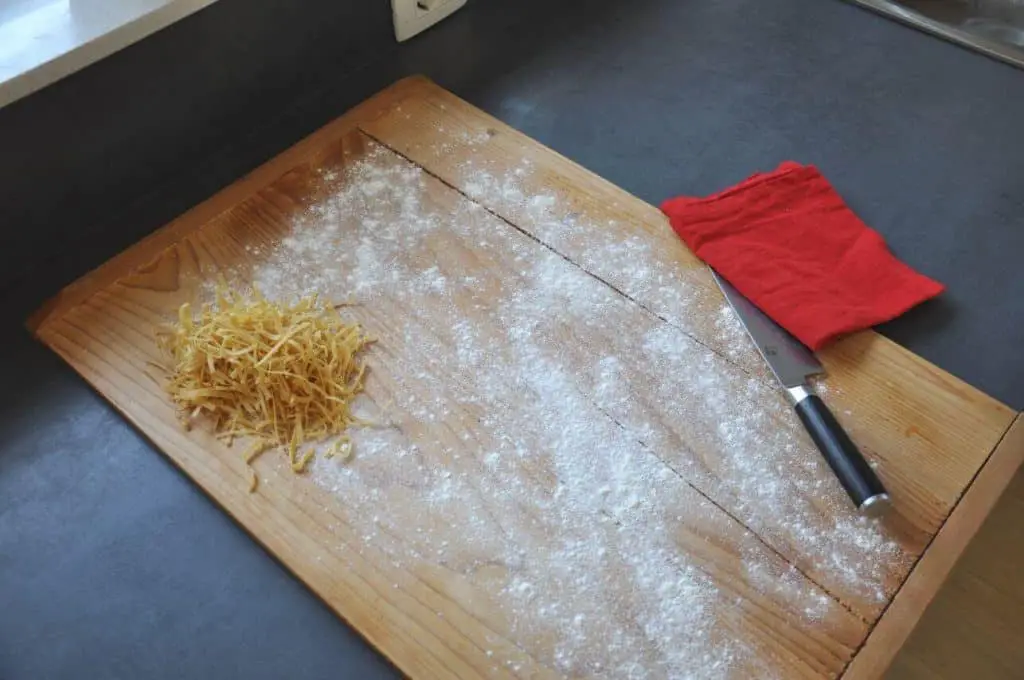
If you want to keep your pasta board for a long time, you should take care of it after use. Following is a simple guide on how to clean your pasta board and how to season it so it will last forever:
Step 1: Dust off leftover flour
Step 2: Scrape off any leftover dough
Step 3: Dry cleaning
Step 4: Wet cleaning
Step 5: Drying
Step 6: Seasoning
Step 7: Storing
How to clean a wooden pasta board or pastry board
Taking care of pasta board is very important. Pasta board is a piece of wood and should be treated accordingly. Following are the steps that will help you preserve pasta board for a long time.
Dust off leftover flour
When you make pasta, you use a lot of flour. Flour is important not only to make pasta but also in the process of kneading and shaping your pasta.
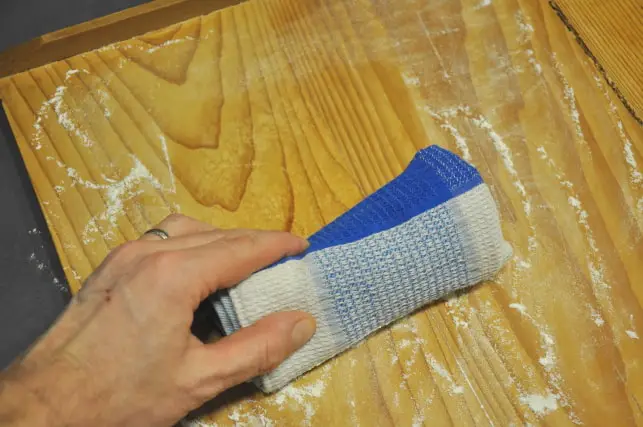
Depending on what kind of dough you made, the amount of flour will be used accordingly. If your dough is too wet, you will use more flour. On the other hand, if your dough is just right and not too wet, you will still use flour.
You don’t want your pasta to stick to your board; that is why you sprinkle a handful of flour under the pasta sheets. You want this flour to last to the last sheet, so the sheets don’t stick to the wooden board.
When you are done, you are left with a dusted board.
Never wash the flour off of the pasta board as it will stick to the board, and it will be much harder to clean it. That is why you should dust it off with a soft and dry kitchen cloth or with a pastry brush like this one:
When you dust off the flour, you are ready for the next step.
Scrape off any leftover dough
Plain white flour, which is mostly used for making pasta, includes gluten. Gluten makes the dough sticky. Want it or not, you will be left with stuck dough on your board.
The best way to get rid of leftover dough is to scrape it off.
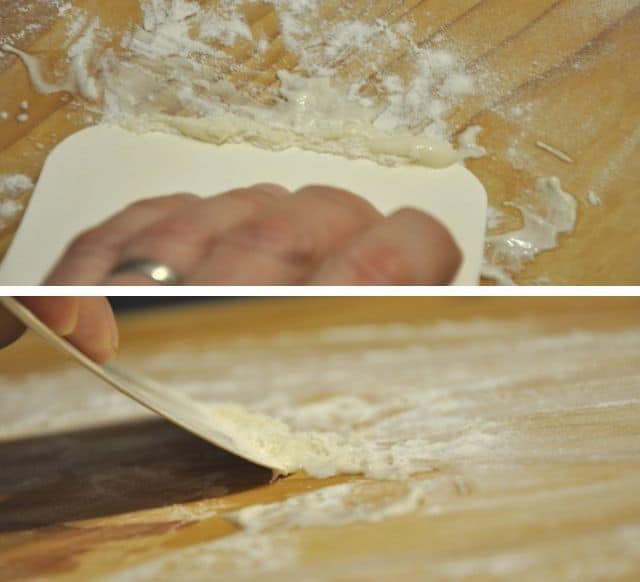
If you apply water and soap, the dough will get wet, and you will spread it all over the board. Luckily there is a better solution:
Use a bench scraper:
A bench scraper is a very versatile tool. It is convenient for cutting pastry and also to clean your board. With this scraper, you will quickly remove any leftover doubt on your board.
Use a plastic putty knife:
A Putty knife is not only used in construction. This tool is perfect for your kitchen. You can use it to scrape off leftover dough from your board or to clean stains or dried up food on any flat surface in your kitchen. I recommend using a plastic one because the stainless steel one can easily damage your board’s surface.
Dry cleaning
The next step is to dry clean the surface. You sort of dry cleaned the surface with your pastry brush and a putty knife, but it is also wise to use a cloth before starting the wet cleaning.
Cleaning the board surface with a dry cloth is very practical. You will remove any remaining stains, dough, and flour. After you are done, the board should look pretty clean.
If your board is very dirty, once you start cleaning, wipe off the surface, fold the towel, and further clean with a clean part of the towel. If you make the entire towel dirty, use a new one.
The towels I use are pretty thick and also washable:
Wet cleaning
The size of wooden pasta boards or pastry board is usually 12.5″ x 17″. Because of the size, it is difficult or practically impossible to wash the board in your kitchen sink.
How you should not wet clean your pasta board
If you want to keep your wooden board for a long time, avoid these two things:
- Never wash it under running tap water.
- Never put it into the dishwasher.
Wood and water, in this case, are enemies. If you continuously wash your board by pouring water all over it for a long time, the board will bend, and you won’t be able to use it anymore.
How you should wet clean your pastry board or pasta board
Always use a soft sponge. If you are using a scrub sponge, never clean the board with the scrubbing side; always use the soft side.
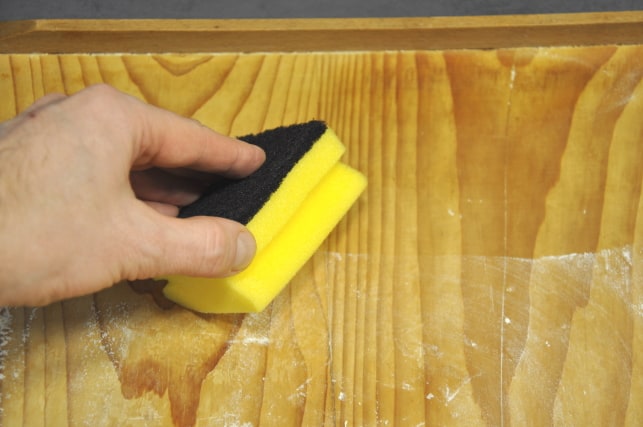
Apply some soap and hot water to the sponge. Wipe the board entirely. There should never be puddles of water on the board after you are done. Puddles are also the best indicator if you applied too much water on the board.
After the first clean, wash the sponge under clean water and wipe the board again. Repeat until the board is clean, and there is no more dough or flour on the board.
When you are done, it is time to dry your board the right way.
Drying
Drying your pasta or pastry board after cleaning is crucial. If you leave your board to simply dry on the air after you washed it with water, the chances of board bending are very high.
The first step is to use a dry kitchen cloth and completely dry wipe the board. If the fabric gets too wet, use a new dry cloth. Water should be wiped off the board completely.
The second step is leaving to board to dry. Don’t just put it on the countertop and leave it to dry. If you washed both sides of the board, you need to dry both sides. If you haven’t washed the bottom part, it is very likely that also the bottom part of the board was in contact with water.
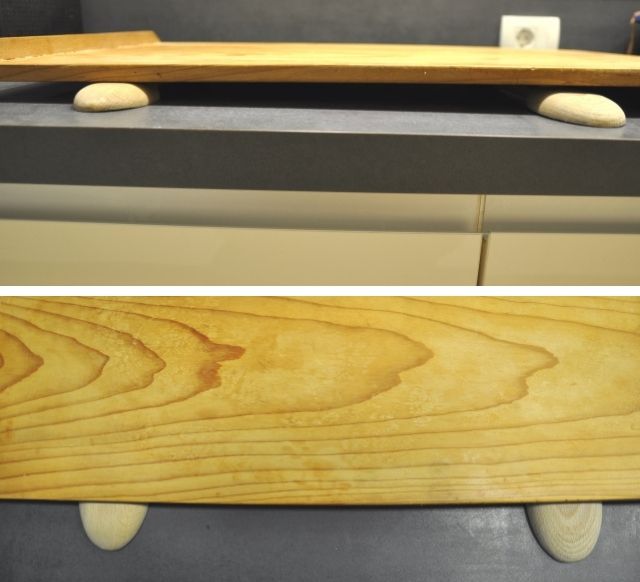
That is why it is essential to dry the board in a dry place and that the board is placed in a way so the air can circulate around the board. The best way is to lean the board on the wall.
If you do leave it to dry on the countertop, do the following:
- Place paper towels under the board so the towels can absorb any access water or humidity that is left in the wood from washing.
- Put a spatula or any other, not sharp, kitchen utensil that you have in the drawer under the board so that the air can circulate and the board can dry completely.
- Leave it on a dish rack. The dish rack is great if you want your board lifted so the air can circulate.
Seasoning and applying oil
You can buy boards that are pre-seasoned with food-grade mineral oils. These boards don’t need to be seasoned every time you wash them.
But if you get an unseasoned board, it is better to apply food-grade mineral oil after cleaning your board. Always apply a thin coating of oil with a soft paper towel and leave it to dry before using the board again.
Here is a good choice when it comes to food-grade mineral oils:
Storing
If you are a huge pasta fan and are making pasta every week or just making pasta occasionally, you need to properly store your pasta board.
Never store the board outside or in a humid place. The board will absorb humid from the surroundings and can bend in time. If you leave the board on the countertop, be sure to put something beneath the board, so the air circulates around the board.
The best way to store your pasta or pastry board is to leave it leaning somewhere in a dry place. If you leave it leaning, the air will circulate, and your board will stay dry and ready for another use.
How do you remove dried or sticky dough off a wooden pasta board
Dried dough
When you knead your dough, you use a lot of force, which is applied to the board. If your dough is too wet, to begin with, a lot of it will stick to the wooden board. Sure, when you add flour, the stuck remainings will be scraped off with the kneading procedure, but not all of it.
When you are done with kneading, you leave your dough to rest. Place the dough on the board, but not in the same place where you kneaded the dough. Instead, place it on the side, but be sure to sprinkle some flour before you leave it to rest.
After a few minutes, the part where you kneaded the dough will be completely dry. Now take your bench scraper or putty knife and scrape off any dough that is stuck on the board after kneading. It is much easier to scrape off dry dough than sticky dough.
Sticky dough
Pasta dough is heavy and dry, and scraping it off won’t be a big problem. But when you are dealing with sticky dough, the cleaning part is a pain.
You have two options when you are dealing with sticky dough.
The first option is to mix the dough with one hand and, at the same time, continuously scrape the sticky dough off of the board. The scraper is a sort of a second hand that helps with kneading and scraping simultaneously.
The second option is to leave the dough that is stuck on the board to dry out and scrape it off with a scraper.
Conclusion
Pasta board or pastry board come in very handy when you are making pasta. But when it comes to cleaning, some extra steps are necessary to preserve the boards wood. These steps are straightforward, and if you follow them every time you clean your board, the board will be as shiny as my grandmother’s after 50 years of making pasta.
